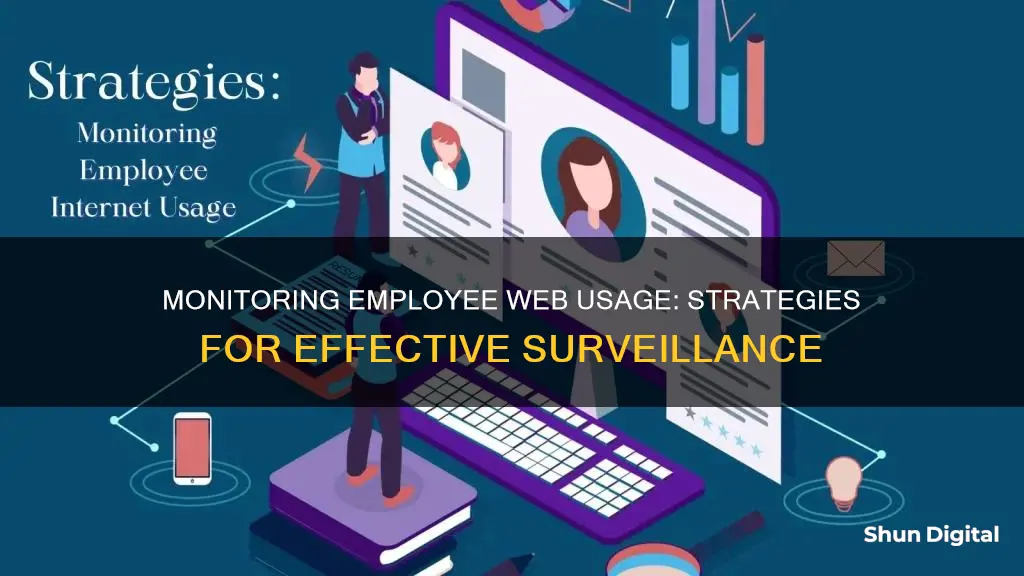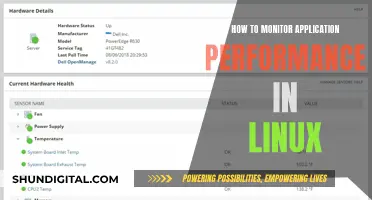
Monitoring employees' web usage is a complex issue that raises questions about ethics, privacy, and the law. On the one hand, employers have a responsibility to ensure their employees are productive and protect company assets and sensitive information. On the other hand, employees have a right to privacy, and excessive monitoring can lead to morale and trust issues. To balance these concerns, employers can implement transparent monitoring policies, focus on behaviours that pose a security risk, and use tools that give employees control over when they are monitored.
| Characteristics | Values |
|---|---|
| Purpose | Protect company assets and ensure smooth functioning of daily operations |
| Data | How and when employees are most productive |
| Data | Potential blockers to productivity, e.g. excessive time spent on non-work-related websites |
| Data | Compliance with legal and regulatory requirements |
| Benefits | Enhance productivity |
| Benefits | Protect company information |
| Benefits | Identify training needs |
| Challenges | Privacy concerns |
| Challenges | Potential for misuse |
| Challenges | Technical difficulties and costs |
| Strategies | Restrict internet usage |
| Strategies | Implement a BYOD policy |
| Strategies | Ban specific websites |
| Strategies | Use an employee monitoring tool |
What You'll Learn

Protect company information
Protecting company information is a crucial aspect of monitoring employees' web usage. Here are some detailed steps and strategies to achieve this:
Strong Data Security Measures
Implement robust access control systems to ensure only authorized personnel can access sensitive data. Set up alerts to notify administrators when unauthorized access attempts are made. Additionally, enforce strong password policies, including regular password changes and the use of complex passwords. Utilize multi-factor authentication to add an extra layer of security for accessing critical systems and data. Protect data with encryption during storage and transmission, and regularly update systems with security patches to address vulnerabilities.
Employee Training and Awareness
Educate employees about data security best practices, such as strong password management, identifying phishing attempts, and avoiding suspicious websites or downloads. Raise awareness about time management and discourage time theft practices to improve productivity. Set clear guidelines on acceptable computer and internet usage, ensuring employees understand the expectations and boundaries.
Employee Monitoring Software
Use remote employee monitoring software to track and analyze employees' internet activities, including downloads, uploads, and online communications. Ensure that monitoring practices comply with legal requirements and respect employees' privacy rights. Communicate monitoring policies transparently to gain employee trust and buy-in.
Implement Strong Policies and Tracking Procedures
Develop and enforce clear policies and procedures regarding data security, acceptable computer usage, and time management. Regularly audit data access and usage patterns to identify any anomalies or unauthorized access attempts. Compare time tracking records with reported hours to detect discrepancies or patterns of time theft.
Secure Remote Work with Remote Monitoring Software
With the rise of remote work, it's important to establish secure remote access protocols, including the use of VPNs and secure connections. Implement endpoint security measures such as firewalls, antivirus software, remote monitoring software, and device encryption to safeguard data on remote devices.
Additional Monitoring Considerations
While monitoring employee internet activity, be mindful of privacy concerns. Gain employee cooperation by explaining the purpose of monitoring practices, such as keystroke logging for data leak prevention rather than punitive measures. Ensure that captured data is securely stored and accessed only by authorized personnel. Adhere to relevant laws and regulations regarding employee monitoring, which vary across regions. Seek legal advice when developing monitoring policies.
Balancing Productivity and Privacy
Employers must strike a balance between monitoring for legitimate business purposes and respecting employee privacy. For example, restrict social media usage to break times instead of banning it during work hours. Only enable specific monitoring features, such as keystroke tracking, for high-risk roles.
Remote Employee Devices
For company-issued devices, install monitoring software to maintain visibility into employees' activities. Use VPNs to route internet traffic through the corporate network for improved monitoring. For personal devices used for work, obtain consent from employees to install monitoring agents, ensuring a clear scope of monitoring and respecting their privacy. Alternatively, prohibit the use of personal devices for work and provide company devices to maintain control over monitoring.
By following these steps and considerations, organizations can effectively protect company information while monitoring employees' web usage.
VA's CPAP Monitoring: How It Works and Why
You may want to see also

Increase productivity
Monitoring employees' web usage can be a sensitive issue, and it's important to respect employees' privacy rights and adhere to legal requirements. However, when implemented correctly, it can be a powerful tool for increasing productivity and enhancing company performance. Here are some ways in which monitoring employees' web usage can increase productivity:
Prevent Cyberloafing:
Cyberloafing, or cyberslacking, refers to employees surfing the web or using the internet for non-work-related reasons. While some cyberloafing can be beneficial, allowing for short breaks and preventing burnout, excessive cyberloafing can lead to decreased productivity. Monitoring web usage can help strike a balance, ensuring that employees' online hours are used appropriately.
Detect Insider Threat Risks:
Employees with unrestricted internet access can inadvertently become a significant security threat. They may download malicious software, visit risky websites, or fall victim to phishing schemes. By tracking user activity and monitoring access to high-risk sites, employers can mitigate these risks and protect their company's data and systems.
Identify Training Needs:
Monitoring web usage can provide insights into employees' skills and knowledge gaps. For example, if certain employees are spending excessive time on particular tasks or websites, it may indicate a need for additional training or support.
Improve Remote Worker Productivity:
With the rise of remote work, monitoring software can help improve visibility into how remote workers spend their time. It creates accountability and provides granular insights into employee activity during work hours, ensuring that they stay focused and productive.
Enhance Data-Informed Management Decisions:
User activity data offers valuable business intelligence beyond just tracking social media usage. It can help identify employees who are struggling to adopt new software or tools, allowing managers to provide additional support or training. Additionally, by understanding the web usage patterns of top performers, managers can create similar structures for struggling employees to improve their productivity.
Optimise Time Management:
By monitoring employees' web usage, managers can identify workers who are taking excessive breaks or abusing rest times. This information can be used to protect the company from productivity losses and ensure that employees are using their time efficiently.
Foster Accountability:
Employee monitoring tools provide insights into how staff utilise their work hours, including access to non-work-related websites and apps. This creates a clear sense of accountability, as employees are aware that their activities are being tracked, leading to improved time management and increased focus on tasks.
Protect Company Information:
Monitoring web usage can help safeguard proprietary information and intellectual property. By preventing the unauthorised sharing or leakage of corporate data, employers can reduce the risk of cyber-attacks and protect sensitive company information.
Comply with Legal and Regulatory Requirements:
In certain industries, such as finance or healthcare, monitoring employee web usage can help organisations comply with legal and regulatory requirements. It ensures that employees adhere to company guidelines and reduces the likelihood of unethical behaviour or misconduct.
Increase Overall Efficiency:
By addressing the issues mentioned above, monitoring employees' web usage can lead to increased efficiency across the organisation. It helps identify and address blockers to productivity, such as excessive time spent on non-work-related sites, and enables the implementation of targeted solutions to improve overall efficiency.
Monitoring Data Usage on Your MacBook Pro: A Guide
You may want to see also

Ensure security compliance
Monitoring employee web usage is a complex issue that requires a careful balance between ensuring security and compliance and respecting employee privacy. Here are some measures to ensure security compliance while monitoring employees' web usage:
Establish Clear and Well-Defined Policies:
It is crucial to have detailed and well-documented policies outlining the monitoring process. These policies should explicitly state what activities will be monitored, how they will be monitored, and the reasons for monitoring. Employees should be required to acknowledge and agree to these policies in writing.
Obtain Employee Consent:
While not legally required in all jurisdictions, obtaining informed consent from employees can help avoid legal issues and build trust. In some states, such as Connecticut, Delaware, Texas, and New York, employee consent is mandatory.
Focus on Legitimate Business Interests:
The monitoring should be justified by legitimate business purposes, such as preventing data breaches, protecting sensitive information, ensuring productivity, or complying with legal requirements. Employers should be able to demonstrate a valid reason for monitoring beyond mere curiosity or micromanagement.
Respect Employee Privacy:
Employers should avoid monitoring activities that employees reasonably expect to be private. This includes personal devices, unless they are used for work-related purposes and the appropriate policies are in place. Avoid monitoring employees outside of work hours without their consent, as this may be considered an invasion of privacy.
Implement Technical Safeguards:
Use monitoring tools that allow for customization and control. For example, set alerts for specific activities or websites that are off-limits, and block or limit access to inappropriate or unproductive websites. This ensures that employees' privacy is respected while still achieving the desired security and compliance goals.
Comply with Relevant Laws and Regulations:
Stay informed about federal, state, and local laws regarding employee monitoring. For example, the Electronic Communications Privacy Act (ECPA) sets restrictions on monitoring electronic communications, and some states have additional privacy laws that employers must adhere to. Consult legal experts to ensure compliance with all applicable regulations.
Be Transparent and Communicative:
Open and honest communication about monitoring practices can help build trust and reduce the negative impact on employee morale. Explain the reasons for monitoring and how it aligns with the company's goals. Provide employees with access to the data collected about them and allow them to challenge any interpretations.
By following these measures, employers can ensure security compliance while respecting the privacy rights of their employees. It is important to stay informed about the latest legal developments and adjust policies accordingly.
OpenLM's Actual Usage Time: Monitoring and Management Strategies
You may want to see also

Identify training needs
Monitoring employee internet usage can help identify areas where employees are struggling and provide targeted training to bridge these gaps.
For example, if data shows that an employee is spending an excessive amount of time on certain websites or applications, it may indicate a lack of proficiency or difficulty performing specific tasks. This information can be used to develop tailored training programs to address these issues.
By tracking employee computer activity, employers can identify common trends or areas where multiple employees are facing challenges. This data can inform the development of comprehensive training programs that address the needs of the entire team, rather than just individuals.
Additionally, monitoring tools can also help identify employees who are highly proficient in specific areas. By understanding the behaviours and activities of top-performing employees, employers can identify best practices and successful strategies that can be shared with the rest of the team through training and knowledge-sharing initiatives.
It is important to note that while monitoring employee internet usage can provide valuable insights for training needs, it should be done ethically and with full transparency. Employees should be aware of the monitoring practices and understand that the purpose is to improve productivity and performance, rather than invade their privacy.
Inns and Internet Privacy: What You Need to Know
You may want to see also

Monitor without invading privacy
Monitoring employees' web usage is a complex issue that requires a careful balance between protecting company interests and respecting employees' privacy rights. Here are some ways to monitor employees' web usage without invading their privacy:
Establish Clear and Transparent Policies
It is crucial to establish a clear and transparent policy for employee monitoring. This policy should outline the purpose, scope, and methods of monitoring, as well as the rights and responsibilities of both the employer and the employee. It is essential to communicate this policy to employees and obtain their consent before implementing any monitoring tools. Regular review and updates of the policy are also necessary to keep up with changing technology, laws, and business needs.
Use MDM Software for Mobile Devices
Mobile Device Management (MDM) software is an effective way to monitor mobile device usage without invading privacy. It allows you to manage and secure all devices from a central console. With MDM software, you can enrol and register devices, configure security settings and policies, distribute and update apps, monitor device activity, and remotely lock and wipe devices. When choosing MDM software, look for features such as compatibility with different device types, scalability, ease of use, compliance with relevant standards, and data protection measures such as encryption and anonymization.
Implement a BYOD Policy
Bring Your Own Device (BYOD) policies can offer employees some freedom to browse the internet on their personal devices during breaks while still protecting company assets. Emphasize that personal devices should be used for personal purposes, and employees should use company devices for work-related tasks. If employees use their personal devices for work, clearly communicate what will be monitored and when, so they don't feel tracked outside of work hours.
Use Employee Monitoring Tools with Care
Employee monitoring software can provide real-time information on how employees spend their time online, including website usage, frequency, and duration. However, it is crucial to use this information solely for its intended purpose of improving productivity and safeguarding company assets. Be transparent about the use of monitoring software, and ensure that employees are aware of the purpose of such tools.
Focus on Relevant Data
When monitoring employees' web usage, collect and access only the data necessary and relevant for business purposes. Limit data retention to the minimum required, and ensure that employees have options and controls over their data. This helps to address privacy concerns and demonstrates respect for employees' privacy.
Comply with Legal Requirements
It is essential to comply with federal and state employee monitoring laws and regulations. While federal privacy laws and most state laws give discretion to employers, some states have specific requirements. For example, Connecticut requires written notification to employees, while California, Florida, Louisiana, and South Carolina have explicit constitutional rights to privacy. New York requires specific notice upon hire and a conspicuous display of monitoring policies. Consult legal counsel to ensure your monitoring practices adhere to all relevant regulations.
Monitoring Bandwidth Usage: Tips for Home Network Management
You may want to see also
Frequently asked questions
Monitoring employees' web usage can help to increase productivity and accountability, as well as reducing security risks. It can also help to identify training needs and protect company information.
There are several ways to monitor employees' web usage, including:
- Restricting internet usage to certain apps or websites
- Implementing a BYOD (bring your own device) policy
- Banning specific websites
- Using an employee monitoring tool, such as Time Doctor or Teramind
In the United States, it is completely legal for employers to monitor their employees' internet activity on company-owned computers. However, there may be state-specific regulations that restrict monitoring to work-related activities only. It is important to review the laws in your region before implementing any employee monitoring system.
Monitoring employees' web usage can raise ethical concerns around privacy rights, the potential for discrimination, and the impact on employee morale. It is important to communicate monitoring policies clearly to employees and to respect their privacy while also protecting the company's interests.
Instead of relying solely on monitoring, employers can adopt educational approaches such as regular training sessions on cybersecurity risks and digital etiquette. Promoting a culture of trust and mutual respect can often lead to more responsible behavior.







